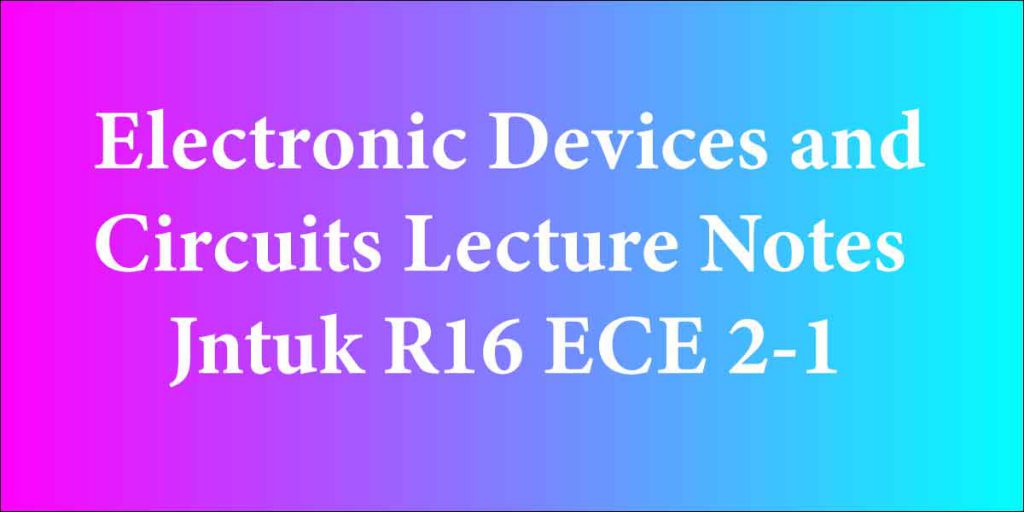Electronic Devices and Circuits
Objectives:
The main objectives of this course are:
• the essential ideas of semiconductor physics ar to be reviewed.
• Study the physical phenomena like physical phenomenon, transport mechanism and electrical characteristics of various diodes.
• the appliance of diodes as rectifiers with their operation and characteristics with and while not filters ar mentioned.
• The principal of operating and operation of Bipolar electronic transistor and Field impact junction transistor and their characteristics ar explained.
• the necessity of junction transistor biasing and its significance is explained. The quiescent purpose or operational purpose is explained.
• little signal equivalent circuit analysis of BJT and {fet|field-effect junction transistor|FET|transistor|junction transistor|electronic transistor} transistor amplifiers in numerous configuration is explained.
Syllabus:
UNIT-I:
Semi Conductor Physics : Insulators, Semi conductors, and Metals classification mistreatment energy band diagrams, quality and physical phenomenon, electrons and holes in intrinsic semi conductors, accidental semi conductors, drift and diffusion, charge densities in semiconductors, Hall impact, continuity equation, law of junction, Fermi Dirac operate, Fermi level in intrinsic and accidental Semiconductors
UNIT- II:
Junction Diode Characteristics : Open circuited tangency, Biased tangency, tangency diode, current parts in PN junction Diode, diode equation, V-I Characteristics, temperature dependence on V-I characteristics, Diode resistance, Diode capacitance, energy band diagram of PN junction Diode.
Special Semiconductor Diodes: Zener Diode, Breakdown mechanisms, Zener diode applications, LED, icon diode, Tunnel Diode, SCR, UJT. Construction, operation and characteristics of all the diodes ar needed to be thought of.
UNIT- III:
Rectifiers and Filters: Basic Rectifier setup, 0.5 wave rectifier, full wave rectifier, bridge rectifier, derivations of characteristics of rectifiers, rectifier circuits-operation, input and output waveforms, Filters, electrical device filter, condenser filter, comparison of varied filter circuits in terms of ripple factors.
UNIT- IV:
junction transistor Characteristics:
BJT: electronic transistor, junction transistor current parts, junction transistor equation, junction transistor configurations, junction transistor as Associate in Nursing electronic equipment, characteristics of junction transistor in Common Base, Common electrode and customary Collector configurations, Ebers-Moll model of a junction transistor, punch through/ reach through, icon junction transistor, typical junction transistor junction voltage values.
FET: junction transistor varieties, construction, operation, characteristics, parameters, MOSFET-types, construction, operation, characteristics, comparison between JFET and MOSFET.
II Year – I Semester
L T P C
4 0 0 3
ELECTRONIC DEVICES AND CIRCUITS
UNIT- V:
junction transistor Biasing and Thermal Stabilization : would like for biasing, operational purpose, water line analysis, BJT biasing- ways, basic stability, fixed bias, collector to base bias, self bias, Stabilization against variations in VBE, Ic, and β, Stability factors, (S, S’, S’’), Bias compensation, Thermal runaway, Thermal stability.
FET Biasing- ways and stabilization.
UNIT- VI:
little Signal Low Frequency junction transistor electronic equipment Models:
BJT: 2 port network, junction transistor hybrid model, determination of h-parameters, conversion of h-parameters, generalized analysis of junction transistor electronic equipment model mistreatment h-parameters, Analysis of CB, Ce and CC amplifiers mistreatment precise and approximate analysis, Comparison of junction transistor amplifiers.
FET: Generalized analysis of little signal model, Analysis of CG, metallic element and CD amplifiers, comparison of junction transistor amplifiers.
Text Books:
- Electronic Devices and Circuits- J. Millman, C. Halkias, Tata Mc-Graw Hill, Second Edition. 2. Integrated Electronics- Jacob Millman, C. Halkies, C.D.Parikh, Tata Mc-Graw Hill, 2009.
References: - Electronic Devices and Circuits-K. Satya Prasad, VGS Book Links. 2. Electronic Devices and Circuits-Salivahanan, Kumar, Vallavaraj, Tata Mc-Graw Hill, Second Edition three. Electronic Devices and Circuits – Bell, Oxford
- Outcomes:
- At the top of this course the coed will in a position to:
• perceive the essential ideas of semiconductor physics. • perceive the formation of tangency and the way it are often used as a tangency as diode in numerous modes of operation. • apprehend the development, rule of rectifiers with and while not filters with relevant expressions and necessary comparisons. • perceive the development, principle of operation of transistors, BJT and junction transistor with their V-I characteristics in numerous configurations. • apprehend the necessity of junction transistor biasing, varied biasing techniques for BJT and junction transistor and stabilization ideas with necessary expressions. • Perform the analysis of little signal low frequency junction transistor electronic equipment circuits mistreatment BJT and junction transistor in numerous configurations.

